#pickle factory
Text

#downpresser#mizery#no empire#cool your jets#speak out#sights#chained down#no sun#dta#blackbeard#pickle factory#2010s#2014
3 notes
·
View notes
Text
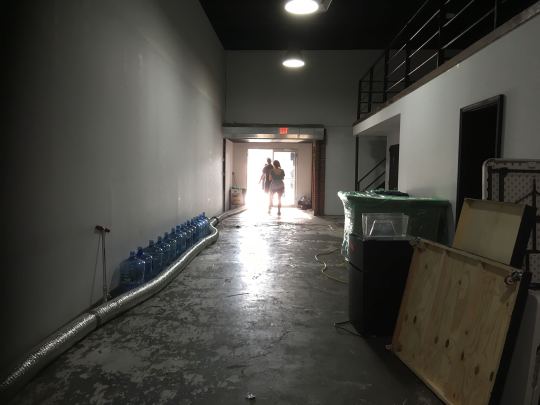
we used to work out of a space that was directly next to a pickle factory with no ac we literally would all get pickled when we worked in this space do you know how difficult it was to be hungover and just smell pickles
#pickle factory#pickle#pickled#hungover#brook#new york#futureproof#bushwick#nyc#immersive#theater#transmedia#brooklyn#immersive theater#immersive theatre#new york city
1 note
·
View note
Text

Pickling plant, 1976. From the Budapest Municipal Photography Company archive.
49 notes
·
View notes
Text

duckduckgo knows what's up
#monster factory#mcelroys#the final pam#final pam#pickle pontificates#sadly i checked and most of these pull up pam from the office. sad
14 notes
·
View notes
Text
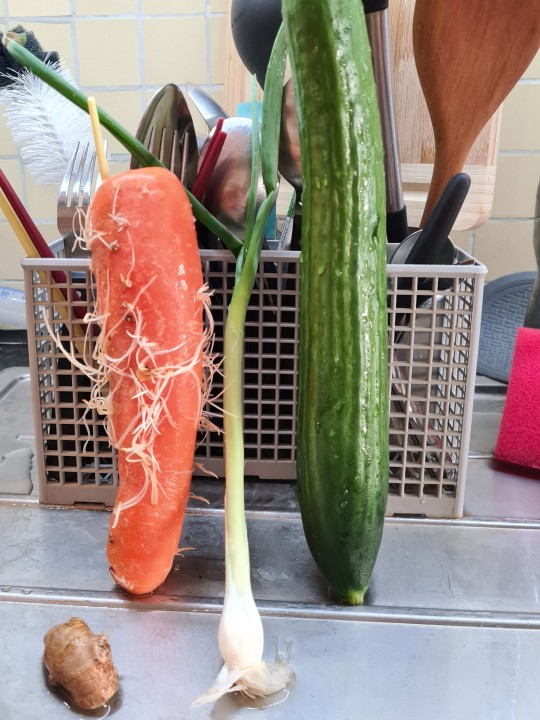

Getting ready to concoct a quick batch of cucumber kimchi shortly! As warm as the weather has been staying, it should be ready to eat tomorrow.
I found that one wildly root-hairy carrot in the bag, so it had better go first. This won't need more than maybe a third of the huge carrot, so I guess I'll be making something else with carrot soon! That ginger came from the store looking a little sad, but it's better than no ginger. I'm just using frozen chopped garlic because what we had fresh was too far past its prime.
Also substituting in a smidgen of that aged miso from the back of the fridge, since we are devoid of any kind of fish sauce. (Thai or Vietnamese style works great, btw.) That's just for a touch of umami anyway, and miso makes a decent vegan stand-in for the seafood products.
I think everything should pack into that sauerkraut jar OK, once it's salted down and wilty. If not, I'll pull out an overflow container.
Pretty much just running on experience here, but this looks like a pretty good recipe:
ETA: I'm also hoping to get a couple of jars of longer storage white cabbage kimchi made, from a wedge of cabbage that's been lurking in the fridge. Hopefully that will happen soon, too. I don't have the energy to do both at the same time today, at least if I want to eat supper.
19 notes
·
View notes
Text
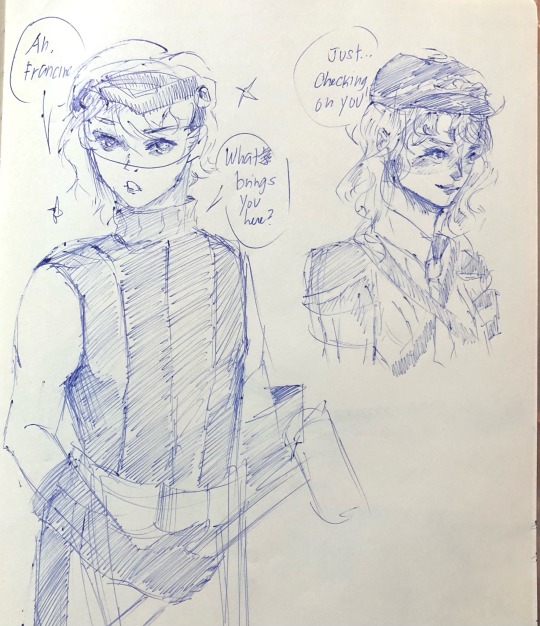

why can i immediately flirt with the mans 😭
#quinttyz draws#HAHAHAHHAHA#martin will be drowning in pickled turnips#havent met all the bachelors yet!! but im already stuck between ryker and martin lol#rune factory 5#rune factory 5 alice#rune factory 5 martin#martin rune factory 5#martin rf5#rf5 martin#rune factory 5 fanart#rf5 fanart
13 notes
·
View notes
Text

"EASY TO OPEN!" Not noticeably, compared to other jars I've encountered. But, go off Felix.
Shame I don't have the before pictures anymore, and can't point to them on my old blog. But, this is the batch of mixed pickles which turned out mostly cabbage, with a handful of standard round red radishes we had thrown in because it seemed worth a try.
(With what was left transferred over into another saved pickle jar, to free up the airlock lid one they were made in.)
While I was fully expecting most of the color to leach out of those radish skins, I really did NOT think it was enough pigment to turn the whole jar so pink.


One of the bleached-out radish halves in question , with a piece of pink onion--and on the right, a chunk of Barbie cabbage.
The color of the carrot slices barely even stands out, in that sea of pinkness. Appearance aside, this turned out to be one of the best tart, garlicky, slightly hot batches of pickles that I have made so far.
So, if you really want some brine pickles that shade of pink, just throw in some of these babies:

It wouldn't even necessarily take that many. Not nearly as potent as beets or red cabbage pigment, but there seems to be more than enough in that thin outer skin layer.
2 notes
·
View notes
Text
Applying BenGay to my neck before I slide into bed is such an aphrodisiac.
#it’s not.#but what else do I say?#I’m fucking old and need to pickle myself to stay alive?#I smell like a doublemint gum factory#I’m so alluring#my husband must be so turned on
2 notes
·
View notes
Text
lots of fun with west of loathing today. More spittoons, found demon clowns, advanced underground technology, the works.
3 notes
·
View notes
Text
youtube
#amazing#mount olive#factory#food#processing#fermentation#pickles#cucumbers#warehouse#north carolina#how it's made#got boring in the later half of the video but still cool#Youtube
2 notes
·
View notes
Text
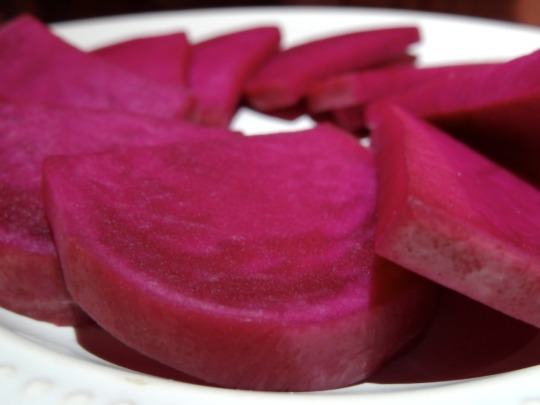
[ID: A circle of overlapping semi-circular bright pink pickles arranged on a plate, viewed from a low angle. End ID]
مخلل اللفت / Mukhallal al-lifit (Pickled turnips)
The word "مُخَلَّل" ("mukhallal") is derived from the verb "خَلَّلَ" ("khallala"), meaning "to preserve in vinegar." "Lifit" (with diacritics, Levantine pronunciation: "لِفِتْ"), "turnip," comes from the root "ل ف ت", which produces words relating to being crooked, turning aside, and twisting (such as "لَفَتَ" "lafata," "to twist, to wring"). This root was being used to produce a word meaning "turnip" ("لِفْتْ" "lift") by the 1000s AD, perhaps because turnips must be twisted or wrung out of the ground.
Pickling as a method of preserving produce so that it can be eaten out of season is of ancient origin. In the modern-day Levant, pickles (called "طَرَاشِيّ" "ṭarāshiyy"; singular "طُرْشِيّ" "ṭurshiyy") make up an important culinary category: peppers, carrot, olives, eggplant, cucumber, cabbage, cauliflower, and lemons are preserved with vinegar or brine for later consumption.
Pickled turnips are perhaps the most commonly consumed pickles in the Levant. They are traditionally prepared during the turnip harvest in the winter; in the early spring, once they have finished their slow fermentation, they may be added to appetizer spreads, served as a side with breakfast, lunch, or dinner, eaten on their own as a snack, or used to add pungency to salads, sandwiches, and wraps (such as shawarma or falafel). Tarashiyy are especially popular among Muslim Palestinians during the holy month of رَمَضَان (Ramaḍān), when they are considered a must-have on the إِفْطَار ("ʔifṭār"; fast-breaking meal) table. Pickle vendors and factories will often hire additional workers in the time leading up to Ramadan in order to keep up with increased demand.
In its simplest instantiation, mukhallal al-lifit combines turnips, beetroot (for color), water, salt, and time: a process of anaerobic lacto-fermentation produces a deep transformation in flavor and a sour, earthy, tender-crisp pickle. Some recipes instead pickle the turnips in vinegar, which produces a sharp, acidic taste. A pink dye (صِبْغَة مُخَلَّل زَهْرِي; "ṣibgha mukhallal zahri") may be added to improve the color. Palestinian recipes in particular sometimes call for garlic and green chili peppers. This recipe is for a "slow pickle" made with brine: thick slices of turnip are fermented at room temperature for about three weeks to produce a tangy, slightly bitter pickle with astringency and zest reminiscent of horseradish.
Turnips are a widely cultivated crop in Palestine, but, though they make a very popular pickle, they are seldom consumed fresh. One Palestinian dish, mostly prepared in Hebron, that does not call for their fermentation is مُحَشّي لِفِتْ ("muḥashshi lifit")—turnips that are cored, fried, and stuffed with a filling made from ground meat, rice, tomato, and sumac or tamarind. In Nablus, tahina and lemon juice may be added to the meat and rice. A similar dish exists in Jordan.
Turnips produced in the West Bank are typically planted in open fields (as opposed to in or under structures such as plastic tunnels) in November and harvested in February, making them a fall/winter crop. Because most of them are irrigated (rather than rain-fed), their yield is severely limited by the Israeli military's siphoning off of water from Palestine's natural aquifers to settlers and their farms.
Israeli military order 92, issued on August 15th, 1967 (just two months after the order by which Israel had claimed full military, legislative, executive, and judicial control of the West Bank on June 7th), placed all authority over water resources in the hands of an Israeli official. Military order 158, issued on November 19th of the same year, declared that no one could establish, own, or administer any water extraction or processing construction (such as wells, water purification plants, or rainwater collecting cisterns) without a new permit. Water infrastructure could be searched for, confiscated, or destroyed at will of the Israeli military. This order de facto forbid Palestinians from owning or constructing any new water infrastructure, since anyone could be denied a permit without reason; to date, no West Bank Palestinian has ever been granted a permit to construct a well to collect water from an aquifer.
Nearly 30 years later, the Interim Agreement on the West Bank and the Gaza Strip (also called the Oslo II Accord or the Taba Agreement), signed by Israel and the Palestine Liberation Organization (PLO) in 1995, officially granted Israel the full control over water resources in occupied Palestine that it had earlier claimed. The Argreement divided the West Bank into regions of three types—A, B, and C—with Israel given control of Area C, and the Palestinian Authority (PA) supposedly having full administrative power over Area A (about 3% of the West Bank at the time).
In fact, per article 40 of Annex 3, the PA was only allowed to administer water distribution in Area A, so long as their water usage did not exceed what had been allocated to them in the 1993 Oslo Accord, a mere 15% of the total water supply: they had no administrative control over water resources, all of which were owned and administered by Israel. This interim agreement was to be returned to in permanent status negotiations which never occurred.
The cumulative effect of these resolutions is that Palestinians have no independent access to water: they are forbidden to collect water from underground aquifers, the Jordan River, freshwater springs, or rainfall. They are, by law and by design, fully reliant on Israel's grid, which distributes water very unevenly; a 2023 report estimated that Israeli settlers (in "Israel" and in the occupied West Bank) used 3 times as much water as Palestinians. Oslo II estimations of Palestinians' water needs were set at a static number of million cubic meters (mcm), rather than an amount of water per person, and this number has been adhered to despite subsequent growth in the Palestinian population.
Palestinians who are connected to the Israeli grid may open their taps only to find them dry (for as long as a month at a time, in بَيْت لَحْم "bayt laḥm"; Bethlehem, and الخَلِيل "al-khalīl"; Hebron). Families rush to complete chores that require water the moment they discover the taps are running. Those in rural areas rely on cisterns and wells that they are forbidden to deepen; new wells and reservoirs that they build are demolished in the hundreds by the Israeli military. Water deficits must be made up by paying steep prices for additional tankards of water, both through clandestine networks and from Israel itself. As climate change makes summers hotter and longer, the crisis worsens.
By contrast, Israeli settlers use water at will. Israel, as the sole authority over water resources, has the power to transfer water between aquifers; in practice, it uses this authority to divert water from the Jordan River basin, subterranean aquifers, and بُحَيْرَة طَبَرِيَّا ("buḥayrat ṭabariyyā"; Lake Tiberias) into its national water carrier (built in 1964), and from there to other regions, including the Negev Desert (south of the West Bank) and settlements within the West Bank.
Whenever Israel annexes new land, settlers there are rapidly given access to water; the PA, however, is forbidden to transport water from one area of the West Bank to another. Israel's control over water resources is an important part of the settler colonial project, as access to water greatly influences the desirability of land and the expected profit to be gained through its agricultural exports.
The result of the diversion of water is to increase the salinity of the Eastern Aquifer (in the West Bank, on the east bank of the Jordan River) and the remainder of the Jordan that flows into the West Bank, reducing the water's suitability for drinking and irrigation; in addition, natural springs and wells in Palestine have run dry. In this environment, water for drinking and watering crops and livestock is given priority, and many Palestinians struggle to access enough water to shower or wash clothing regularly. In extreme circumstances, crops may be left for dead, as Palestinian farmers instead seek out jobs tending Israeli fields.
Some areas in Palestine are worse off in this regard than others. Though water can be produced more easily in the قَلْقِيلية (Qalqilya), طُولْكَرْم (Tulkarm) and أَرِيحَا ("ʔarīḥā"; Jericho) Districts than in others, the PA is not permitted to transfer water from these areas to areas where water is scarcer, such as the Bethlehem and Al-Khalil Districts. In Al-Khalil, where almost a third of Palestinian acreage devoted to turnips is located [1], and where farming families such as the Jabars cultivate them for market, water usage averaged just 51 liters per person per day in 2020—compare this to the West Bank Palestinian average of 82.4 liters, the WHO recommended daily minimum of 100 liters, and the Israeli average of 247 liters per person per day.
As Israeli settlement גִּבְעַת חַרְסִינָה (Givat Harsina) encroached on Al-Khalil in 2001, with a subdivision being built over the bulldozed Jabar orchard, the Jabars reported settlers breaking their windows, destroying their garden, throwing rocks, and holding rallies on the road leading to their house. In 2010, with the growth of the קִרְיַת־אַרְבַּע (Kiryat Arba) settlement (officially the parent settlement of Givat Harsina), the Jabars' entire irrigation system was repeatedly torn out, with the justification that they were stealing water from the Israeli water authority; the destruction continued into 2014. Efforts at connecting and expanding Israeli settlements in the Bethlehem area continue to this day.
Thus we can see that water deprivation is one tool among many used to drive Palestinians from their land; and that it is connected to a strategy of rendering agriculture impossible or unprofitable for them, forcing them into a state of dependence on the Israeli economy.
Turnips, as well as cabbage and chili peppers, are also grown in the village of وَادِي فُوقِين (Wadi Fuqin), west of Bethlehem. In 2014, Israel annexed about 1,250 acres of land in Wadi Fuqin, or a third of the village's land, "effectively [ruling] out development of the village and its use of this land for agriculture." Most of this land lies immediately to the west of a group of settlements Israel calls גּוּשׁ עֶצְיוֹן ("Gush Etzion"; Etzion Bloc). Building here would link several non-contiguous Israeli settlements with each other and with القدس (Al-Quds; "Jerusalem"), hemming Palestinians of the region in on all sides (many main roads through Israeli settlements cannot be used by anyone with a Palestinian ID). [2] PLO executive committee member Hanan Ashrawi said that the annexation, which was carried out "[u]nder the cover of [Israel's] latest campaign of aggression in Gaza," "represent[ed] Israel’s deliberate intent to wipe out any Palestinian presence on the land".
This, of course, was not the beginning of this strategy: untreated sewage from Gush Etzion settlements had been contaminating crops, springs, and groundwater in Wadi Fuqin since 2006, which also saw nearly 100 acres of Palestinian land annexed to allow for expansion of the Etzion Bloc.
All of this has obviously had an effect on Palestinian agriculture. A 1945–6 British survey of vegetable production in Palestine found that 992 dunums were devoted to Arab turnip production (954 irrigated and 38 rain-fed; no turnip production was attributed to Jewish settlers). A March 1948 UN report claimed that "[i]n most districts the markets are well-supplied with all the common winter vegetables—cabbages, cauliflowers, lettuce and spinach; carrots, turnips and and beets; beans and peas; green onions, eggplants, marrows and tomatoes." By 2009, however, the area given to turnips in Palestine had fallen to 918 dunums. Of these, 864 dunums were irrigated and 54 rain-fed. This represents an increase in unirrigated turnips (5.8%, up from 3.9%) that is perhaps related to difficulty in obtaining sufficient water.
Meanwhile, Israel profits from its restriction of Palestinian agriculture; it is the largest exporter of turnips in West Asia (I found no data for turnip exports from Palestine after 1922, suggesting that the produce is all for local consumption).
The pattern that Ashrawi called out in 2014 continued in 2023, as Israel's genocide in Gaza occurs alongside the continued and escalating killing and expulsion of West Bank Palestinians. The 2014 annexations, which represented the largest land grab for over 30 years and which appeared to institute a new era of state policy, have been followed up in subsequent years with more land claims and settlement-building.
Israeli military and settler raids and massacres in the West Bank, which had already killed 248 in 2023 before the حَمَاس (Hamas) October 7 offensive had taken place, accelerated after the attack, with forced expulsions of Palestinians (including Bedouin Arabs), and harassment, raids, kidnappings, and torture of Palestinians by a military armed with rifles, tanks, and drones. This violence has been opposed by armed resistance groups, who defend refugee camps from military raids with strategies including the use of improvised explosives.
Support Palestinian resistance by buying an e-sim for distribution in Gaza; donating to help two Gazans receive medical care; or donating to help a family leave Gaza.
[1] 918 dunums were devoted to turnips according to the Palestinian Central Bureau of Statistics (PCBS) report for 2009; the 2008 PCBS report attributes 253 dunums of turnip cultivation to Al-Khalil ("Hebron") for 2006–7.
[2] Today, Gush Etzion is connected to Al-Quds by an underground road that runs beneath the Palestinian Christian town of بَيتْ جَالَا (Bayt Jala).
Ingredients:
Makes 2 1-liter mason jars.
500g (4 medium) turnips
1 beetroot
1 medium green chili pepper (فلفل حار خضرة), halved
2 small cloves garlic, peeled
1 liter (4 cups) distilled or filtered water
25g coarse sea salt (or substitute an equivalent weight of any salt without iodine)
Some brining recipes for lifit call for the addition of a spoonful of sugar. This will increase the activity of lactic-acid-producing bacteria at the beginning of the fermentation, producing a quicker fermentation and a different, sourer flavor profile.
Instructions:
1. Clean two large mason jars thoroughly in hot water (there is no need to sterilize them).
2. Scrub vegetables thoroughly. Cut the top (root) and bottom off of each turnip. Cut each turnip in half (from root end to bottom), and then in 1 cm (1/2") slices (perpendicular to the last cut). Prepare the beetroot the same way.
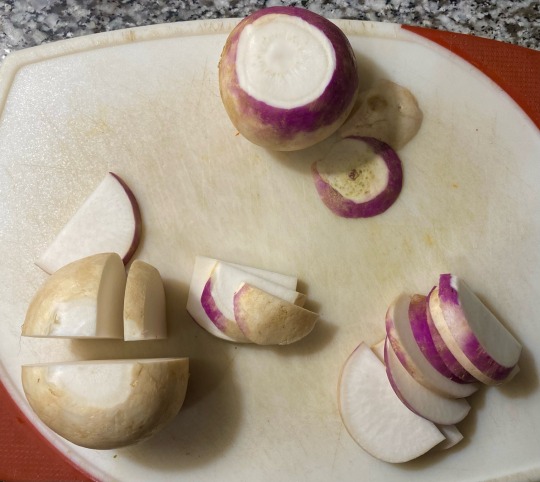
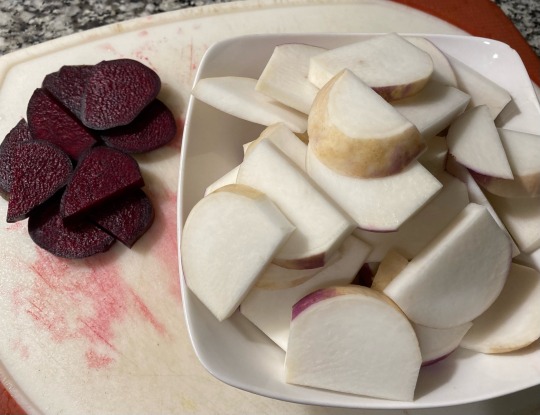
If you need your pickles to be finished sooner, cut the turnips into thinner slices, or into thick (1/2") baton shapes; these will need to be fermented for about a week.
3. Arrange turnip and beet slices so that they lie flat in your jars. Add garlic and peppers.
4. Whisk salt into water until dissolved and pour over the turnips until they are fully submerged. Seal with the jar's lid and leave in a cool place, or the refrigerator, for 20–24 days.

The amount of brine that you will need to cover the top of the vegetables will depend on the shape of your jar. If you add more water, make sure that you add more salt in the same ratio.

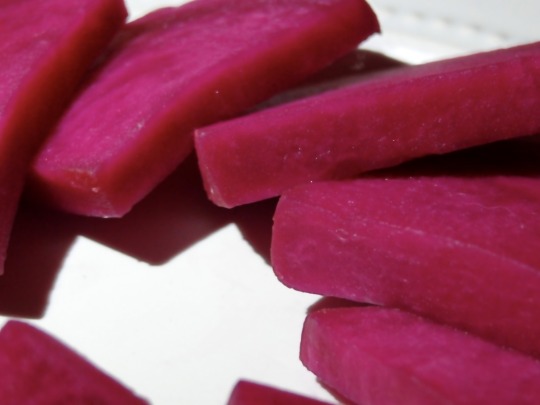
289 notes
·
View notes
Text
Midnight Pals: Cage Match
Stephen King: submitted for the approval of the
Elon Musk: [busting out of the bushes] eyyyyy stephano king! you thinka you so smart
Musk: you thinka you smart but elon muska he da smartest man inna world ey? oh!!!
Musk: [steps on rake]
Musk: eyyyy paisano!!!
Poe: steve who is this
King: no one, just ignore him guys
Musk: eyyyy ima pickle rick!
Poe: steve is this a friend of yours
King: no guys i just
Musk: gotsa gitsa friggata!!!
Poe: steve could you ask your friend to keep it down
Musk: eyyy stephano king you no lika you blue check? friendship witha stephano king ended!
King: we weren't friends elon
Musk: jk rowling issa my new besta friend!
Musk: we onna da same page!
JK Rowling: i want to eat your transss daughter too
Musk: lika two peasa inna pod!
Musk: issa me elon musk!
Musk: i bann da color yellow from my tesla factory cusa i no like it!
Musk: eyy maybe i banna da color yellow from twitter! eyyy!!
Robert W Chambers: but wait i need that color to live
Musk: eyyy i say da color yellow issa slur!! ey!!!
Musk: eyyyy i fighta inna cage match witha mark zuckerberg! oh!!!
Musk: just lika my hero lowtax fighta inna cage match witha uwe boll!
Barker: oh yeah? how'd that match go for lowtax
Musk: eh i forgetta
Musk: it probably go real good eh?
King: you really think you could take mark zuckerberg?
Musk: ey!! i'ma pickle rick!! i beata da zuck cuz my meme game issa strong!
King: zuckerberg literally has an arena where he hunts men for sport, elon
King: i feel like you might not be taking this as seriously as you should
Elon Musk: eyyy!!! i maka da meme!! i lika da dogecoin!!
Mark Zuckerberg: [with eerie robotic calm] i have no animosity toward mr musk, but i will make orphans of his children. before the sun sets, i will slake my thirst with his blood. death will be a mercy that shall not come
Elon Musk: eyyy!!! I puncha da zuck! Oh!!
[Mark Zuckerberg immediately delivers killing blow]
King: oh shit!
Poe: oh no!
Barker: hahaaha hope you got $10 dude!!!
#midnight pals#the midnight society#midnight society#stephen king#clive barker#edgar allan poe#jk rowling#robert w chambers#elon musk#mark zuckerberg
709 notes
·
View notes
Note
i've got two questions that kind of came from each other
how/why does everyone eat? isn't the poppy serum all they would need? or do they still have stomachs or something?
what is the critters fav foods if they could have anything appear in the factory?
there had been a lot of question about the food in the factory, so let answer this part by part
1-what do they eat?
Mostly, Lillith's babies, aka the PJ's that are all around the factory. BUT those are more like a placebo, 'cause their ''meat'' is just like a Jelly poppy serum, have a meaty texture, but isn't meat.
2-Is the Poppy Serum enough?
Is and isn't. You see, the Poppy serum can keep them alive, but they still feel hunger, but is a specific hunger, so there's come the next question
3-Why there's still food (the lemonade or ingredients like sugar and flour) in the factory?
'Cause the experiments doesn't crave that kind of food, yeah, they can eat it to distract their stomach and get energy, but their body crave is for meat, so even when they try to use placebos like food make with poppy serum/ Pj meat, they still fell the need to eat real meat. Is like when you see kids eating dirt and realised that said child have a mineral deficit that make them look for said mineral by eating what they shouldn't (i saw it a lot with some of my cousins), they have a specific need that can only be satisficed with meat.
4-What would be their favorite food?
Even with the meat need, they still enjoy the flavour of food, and have they fav ones.
-Nell loves anything that have chocolate in it (ironic for a dog), but hate peanut butter.
-Callem love soup, any kind of soup. It remember him of when his mother would take care of him when sick. And he hate oatmeal, is disgusting.
-Charlie hate anything sweet, he can't stand it. On the other hand, if he could he would eat pickles like they're chips while reading.
-Alba like cookies, but is the only type of sweet she like. On the other hand, she hate coffee, but can stand the favour for the next reason.
-Nicole loves coffee, is the only thing that can help her when she's stressed, and she had been drinking it even before the hour of joy (by taking the employees cups without them noticing it), so theres a big bag of coffee in the kitchen that she found in the council and has been her treasure since then. Everybody knows that the moment the bag is empty they need to found a alternative, 'cause a stressed Nico isn't something they would like to deal.
-Samina isn't a picky eater, she have a lot of fav food and even if she doesn't like a specific ingredient, she can make it work to make it less disgusting. The only thing she write the line is with seafood, the smell and texture has always make her puke.
-Amara eat anything sweet, BUT she learn she hate alcoholic things when she tried the fermented lemonade, she almost puke her whole stomach that day.
126 notes
·
View notes
Text
cubfan135 fact #155:
Cub wrote a song dedicated to his dye farm 🎶
transcript/lyrics:
Cub: I may or may not have went ahead and completed all of the dye farms we need for this firework factory, and if that were to have happened, let’s say hypothetically, perhaps there would be some type of song about it.
Cub (pitched up): Hey, what’d you hear?
Cub (pitched down): I heard there’s a feather farm.
(ominous drum beat in the background as Cub sings/chants)
Cub: One (one), Rosebush for fun
Two (two), Lilac for you
Three (three), It’s the pe-o-ny
Four (four), Sunflowers more
Five (five), Cactus lookin’ alive
Six (six), Sea pickle mix
Seven (seven), Torchflowers in heaven
Eight (eight), Pitcher pod don’t wait
Nine (nine), Cocoa beans on line
And ten is where bonemeal begins again
(x2)
Cub (pitched up): Okay, great. I don’t know what I’m supposed to do with that.
122 notes
·
View notes
Text

New batch of pickles now underway! I did decide to cut the bigger Brussels sprouts in half, and threw the small ones in whole.
Those ended up filling less of the airlock lid Kilner jar than expected, so time for another illustration of how peeling will cover a multitude of produce sins.
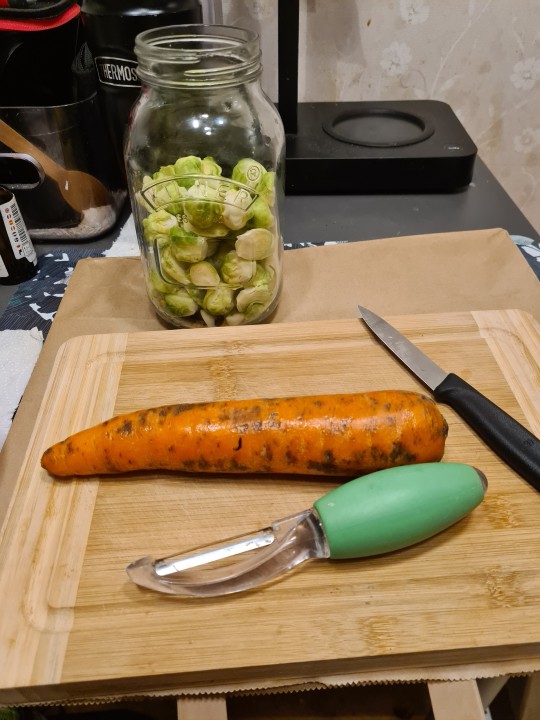
I actually ended up grabbing another of those big carrots too, and cut them fairly chunky to go with the theme. These are not going to be nicely sandwich sliced pickles already.

Seasonings this time: my standard bay leaf-mustard seed-mixed peppercorn combo and a couple of large cloves of garlic--plus, this time I decided to try a few lightly crushed juniper berries in there, for variety. I didn't use much juniper because the taste can get pretty strong. It does go well with pepper and bay leaves in Weinkraut, though, which is what made me think to try some in these.
Top it up with water, weigh the jar to add 3% salt in, and we should be set.
I finished that off with a spare already-pickled homegrown chili, and a piece of cabbage leaf out of the same previous batch as a cap on top to help keep anything else from floating up around the edges around the pickling weight. That's why this jar is already looking a little cloudy at the top. It was there, and if anything should help act as a starter to get the fermentation kicked off.
9 notes
·
View notes
Text




Since getting my Skullector Jack Skellington, I've wanted to make a Sally doll to go with him since I didn't like the Sally doll that came with him.
I opted for a Lagoona base doll because of her round features as well as her blue skin is a lot more desaturated than the official doll. I used Burgundy Wine saran hair from @customdollhairAU since it's a lot darker and less orange toned than the official doll. I really didn't agree with a lot of the creative choices on the official Sally doll, so I wanted mine to suit the desaturated nature of the film.
I did debate on adding as much detail or replicating the factory look of the official doll, but it really didn't mesh well with Jack's stylisation, so I pared things down. I don't understand why the official Sally's sclera has shading on her lower lash line since the shadow is usually cast by the upper eyelid, and I think for a Tim Burton design, no sclera shading is more important for that intense look.
I also opted for more intensely rounded eyes since the almond-shaped eyes on the official doll seem like a strange choice in emulating Tim Burton's style.
I did play around with eyebrows, but since I held her next to Jack, I felt a more simple and minimalistic look was needed to gell them together.
91 notes
·
View notes